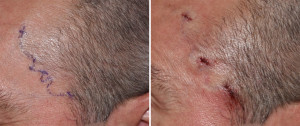Unaesthetic bulging vessels in the temporal region at the side of the forehead are caused by the anterior branch of the superficial temporal artery. Why it gets enlarged is not precisely known although it appears to occur almost exclusively in men. Its enlargement is clearly related to increased blood flow as the vessel becomes most symptomatic with exercise, heat and alcohol intake.
Treatment of prominent temporal vessels can be done by a temporal artery ligation procedure. It would seem logical that if the most proximal portion of the temporal artery were tied off that would provide an immediate solution to the problem by reducing inflow into the vessel. But it is not quite that simple. The anterior branch of the superficial temporal artery has a tortuous course and may have more than one inflow branch into it as it ascends into upper forehead. Anatomic drawings of the vascular patterns of the face are not always accurate or as consistent as they appear.

The ligation points are all exposed and the sutures placed around them but none of them are tied. Then in a descending fashion the sutures are tied down as the blood in the vessels is digitally forced out of the vessel in a retrograde fashion. This allows the vessels to hopefully collapse as they are tied.

Dr. Barry Eppley
Indianapolis, Indiana



